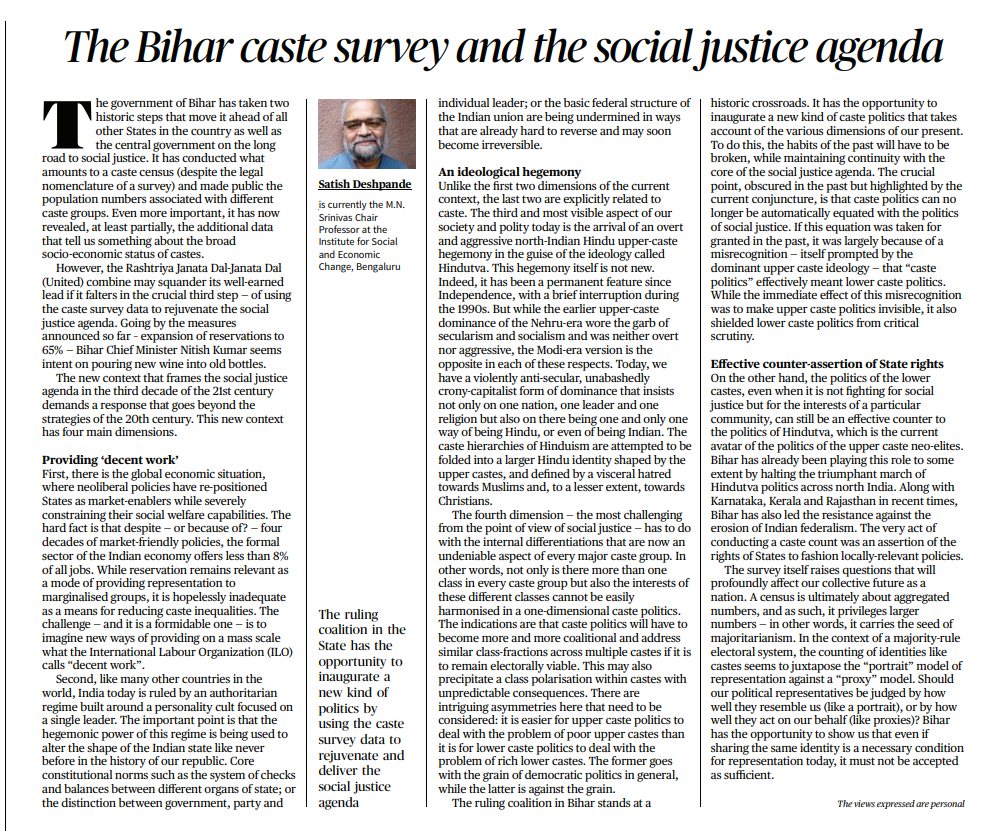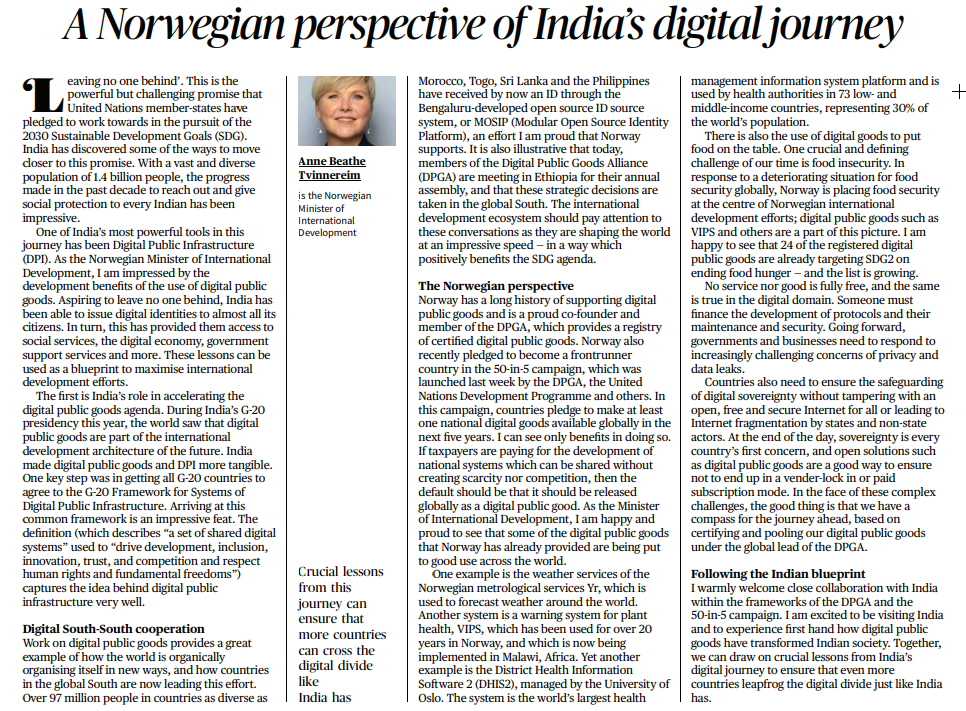Introduction:
- The government of Bihar has undertaken two significant initiatives, a caste census and the disclosure of population data linked to various caste groups.
- These actions position Bihar ahead of other states and the central government in the pursuit of social justice.
- However, the success of these efforts hinges on the government’s ability to utilize the caste survey data effectively to rejuvenate the social justice agenda.
Economic Context and the Need for “Decent Work”:
- The first dimension of the current context is the global economic situation, where neoliberal policies have shifted states towards being market enablers.
- Despite four decades of market-friendly policies, the formal sector in India provides less than 8% of jobs.
- While reservations remain relevant for representation, they are deemed inadequate for reducing caste inequalities.
- The challenge lies in devising new ways, on a mass scale, to provide what the International Labour Organization terms “decent work.”
Authoritarian Shift in Indian Politics:
- The second-dimension highlights India’s transition to an authoritarian regime, with power centralized around a single leader.
- This shift challenges core constitutional norms, eroding checks and balances, and impacting the federal structure of the Indian union.
- The irreversible alterations to the state’s shape demand a response aligned with the evolving political landscape.
Hindutva and Caste Hegemony:
- The third dimension underscores the emergence of an overt and aggressive north-Indian Hindu upper-caste hegemony under the banner of Hindutva.
- This dominance, marked by anti-secularism and crony capitalism, attempts to fold caste hierarchies into a larger Hindu identity shaped by the upper castes.
- The ideology exhibits a visceral aversion towards Muslims and, to a lesser extent, Christians.
Internal Differentiations Within Caste Groups:
- The fourth and most challenging dimension relates to internal differentiations within major caste groups.
- It emphasizes that caste politics must evolve into more coalitional structures, addressing class-fractions across multiple castes.
- This internal diversification may lead to class polarisation within castes, posing unpredictable consequences.
Political Crossroads in Bihar:
- The ruling coalition in Bihar faces a historic opportunity to inaugurate a new era of caste politics that accommodates the multifaceted dimensions of the present.
- Breaking away from past habits while maintaining continuity with the core of the social justice agenda is crucial.
- The editorial analysis highlights that caste politics can no longer be automatically equated with the politics of social justice.
Bihar’s Role in Countering Hindutva:
- Bihar, along with other states like Karnataka, Kerala, and Rajasthan, has played a role in resisting the erosion of Indian federalism and countering Hindutva politics.
- The act of conducting a caste census itself asserts the rights of states to formulate locally-relevant policies, presenting an effective counter-assertion of state rights.
Conclusion:
Bihar’s recent actions mark a pivotal moment in addressing social justice in the evolving socio-political landscape.
The caste census and associated data provide an opportunity for Bihar to redefine caste politics, recognizing its complexities and moving beyond traditional paradigms.
The state’s response will determine its effectiveness in countering the challenges posed by an authoritarian shift, Hindutva ideology, and internal differentiations within caste groups.
"Leaving No One Behind" - India's Digital Public Infrastructure and Global Cooperation
Introduction:
The editorial explores India’s progress in achieving the United Nations’ “Leaving No One Behind” promise through the utilization of Digital Public Infrastructure (DPI).
The focus is on the country’s impressive strides in providing digital identities to its vast population of 1.4 billion people, enabling access to social services, the digital economy, and government support.
India’s Digital Public Infrastructure (DPI):
- India’s success in reaching its social protection goals is attributed to the strategic use of DPI.
- The editorial emphasizes the issuance of digital identities to almost all citizens, facilitating access to various services.
- The DPI is positioned as a powerful tool in realizing the global commitment to inclusive development.
G-20 Framework for Systems of Digital Public Infrastructure:
- During India’s G-20 presidency, a significant achievement was the establishment of the G-20 Framework for Systems of Digital Public Infrastructure.
- This common framework defines DPI as a set of shared digital systems driving development, inclusion, innovation, trust, competition, and respecting human rights.
- The editorial highlights the importance of this framework in shaping the future international development architecture.
Digital South-South Cooperation:
- The editorial highlights the organic organization of the world, with countries in the global South leading efforts in digital public goods.
- Over 97 million people in various countries have received digital IDs through the open-source ID system, MOSIP, developed in Bengaluru.
- The Digital Public Goods Alliance‘s annual assembly in Ethiopia exemplifies the growing influence of the global South in shaping international development efforts.
Norway’s Perspective and Global Contributions:
- Norway’s commitment to digital public goods is underscored, with its active participation in the Digital Public Goods Alliance and recent pledge to the 50-in-5 campaign.
- The editorial cites examples of Norway’s digital public goods, such as weather services, health information systems, and agricultural warnings, contributing to global efforts, particularly in achieving Sustainable Development Goal 2 on ending food hunger.
Challenges and Considerations:
- The editorial acknowledges the financial aspects of digital public goods, emphasizing the need for sustainable funding for protocol development, maintenance, and security.
- It calls for a balance between privacy concerns, data leaks, and the imperative to safeguard digital sovereignty without compromising an open, free, and secure internet.
Collaboration and Learning from India’s Blueprint:
- The editorial concludes with a call for collaboration with India within the frameworks of the Digital Public Goods Alliance and the 50-in-5 campaign.
- It expresses eagerness to draw lessons from India’s digital journey to help more countries leapfrog the digital divide and advance the global commitment to “Leaving No One Behind.”
Conclusion,
The editorial analyisis highlights India’s innovative use of digital public infrastructure, global cooperation efforts, and the importance of learning from successful models to achieve inclusive and sustainable development.



